So I have been trying to make a motion tracker to track a dog moving in a video (recorded Top-down) retrieve a cropped video showing the dog and ignore the rest of the background.
I tried first with object tracking using the available algorithms in opencv 3 (BOOSTING, MIL, KCF, TLD, MEDIANFLOW, GOTURN(returns an error, couldn't solve it yet)) from this link and I even tried a basic algorithm for motion tracking by subtracting the first frame, but none of them gives a good result. Link
I would prefer a code with a preset rectangle box that surrounds the area of motion once it is detected. Something like in this video
I'm not very familiar with OPENCV, but I believe single motion tracking is not supposed to be an issue since a lot of work has been done already. Should I consider other libraries/APIs or is there a better code/tutorial I can follow to get this done? my point is to use this later with neural network (which is why I'm trying to solve it using python/opencv)
Thanks for any help/advice
Edit:
I removed the previous code to make the post cleaner.
Also, based on the feedback I got and further research, I was able to modify some code to make it close to my wanted result. However, I still have an annoying problem with the tracking. It seems like the first frame affects the rest of the tracking since even after the dog moves, it keeps detecting its first location. I tried to limit the tracking to only 1 action using a flag, but the detection gets messed up. This is the code and pictures showing results:
jimport imutils
import time
import cv2
previousFrame = None
def searchForMovement(cnts, frame, min_area):
text = "Undetected"
flag = 0
for c in cnts:
# if the contour is too small, ignore it
if cv2.contourArea(c) < min_area:
continue
#Use the flag to prevent the detection of other motions in the video
if flag == 0:
(x, y, w, h) = cv2.boundingRect(c)
#print("x y w h")
#print(x,y,w,h)
cv2.rectangle(frame, (x, y), (x+w, y+h), (0, 255, 0), 2)
text = "Detected"
flag = 1
return frame, text
def trackMotion(ret,frame, gaussian_kernel, sensitivity_value, min_area):
if ret:
# Convert to grayscale and blur it for better frame difference
gray = cv2.cvtColor(frame, cv2.COLOR_BGR2GRAY)
gray = cv2.GaussianBlur(gray, (gaussian_kernel, gaussian_kernel), 0)
global previousFrame
if previousFrame is None:
previousFrame = gray
return frame, "Uninitialized", frame, frame
frameDiff = cv2.absdiff(previousFrame, gray)
thresh = cv2.threshold(frameDiff, sensitivity_value, 255, cv2.THRESH_BINARY)[1]
thresh = cv2.dilate(thresh, None, iterations=2)
_, cnts, _ = cv2.findContours(thresh.copy(), cv2.RETR_EXTERNAL, cv2.CHAIN_APPROX_SIMPLE)
frame, text = searchForMovement(cnts, frame, min_area)
#previousFrame = gray
return frame, text, thresh, frameDiff
if __name__ == '__main__':
video = "Track.avi"
video0 = "Track.mp4"
video1= "Ntest1.avi"
video2= "Ntest2.avi"
camera = cv2.VideoCapture(video1)
time.sleep(0.25)
min_area = 5000 #int(sys.argv[1])
cv2.namedWindow("Security Camera Feed")
while camera.isOpened():
gaussian_kernel = 27
sensitivity_value = 5
min_area = 2500
ret, frame = camera.read()
#Check if the next camera read is not null
if ret:
frame, text, thresh, frameDiff = trackMotion(ret,frame, gaussian_kernel, sensitivity_value, min_area)
else:
print("Video Finished")
break
cv2.namedWindow('Thresh',cv2.WINDOW_NORMAL)
cv2.namedWindow('Frame Difference',cv2.WINDOW_NORMAL)
cv2.namedWindow('Security Camera Feed',cv2.WINDOW_NORMAL)
cv2.resizeWindow('Thresh', 800,600)
cv2.resizeWindow('Frame Difference', 800,600)
cv2.resizeWindow('Security Camera Feed', 800,600)
# uncomment to see the tresh and framedifference displays
cv2.imshow("Thresh", thresh)
cv2.imshow("Frame Difference", frameDiff)
cv2.putText(frame, text, (10, 20), cv2.FONT_HERSHEY_SIMPLEX, 0.5, (0, 0, 255), 2)
cv2.imshow("Security Camera Feed", frame)
key = cv2.waitKey(3) & 0xFF
if key == 27 or key == ord('q'):
print("Bye")
break
camera.release()
cv2.destroyAllWindows()
This picture shows how the very first frame is still affecting the frame difference results, which forces the box to cover area with no motion.
This one shows a case when motion is ignored an no-longer existing motion (frame difference from the second and first frames of the video) being falsely detected. When I allow multiple tracking it tracks both, which is still wrong since it detects an empty area.
Does anyone have an idea where the code is wrong or lacking ? I keep trying but cannot get it to work properly.
Thank you in advance !!

